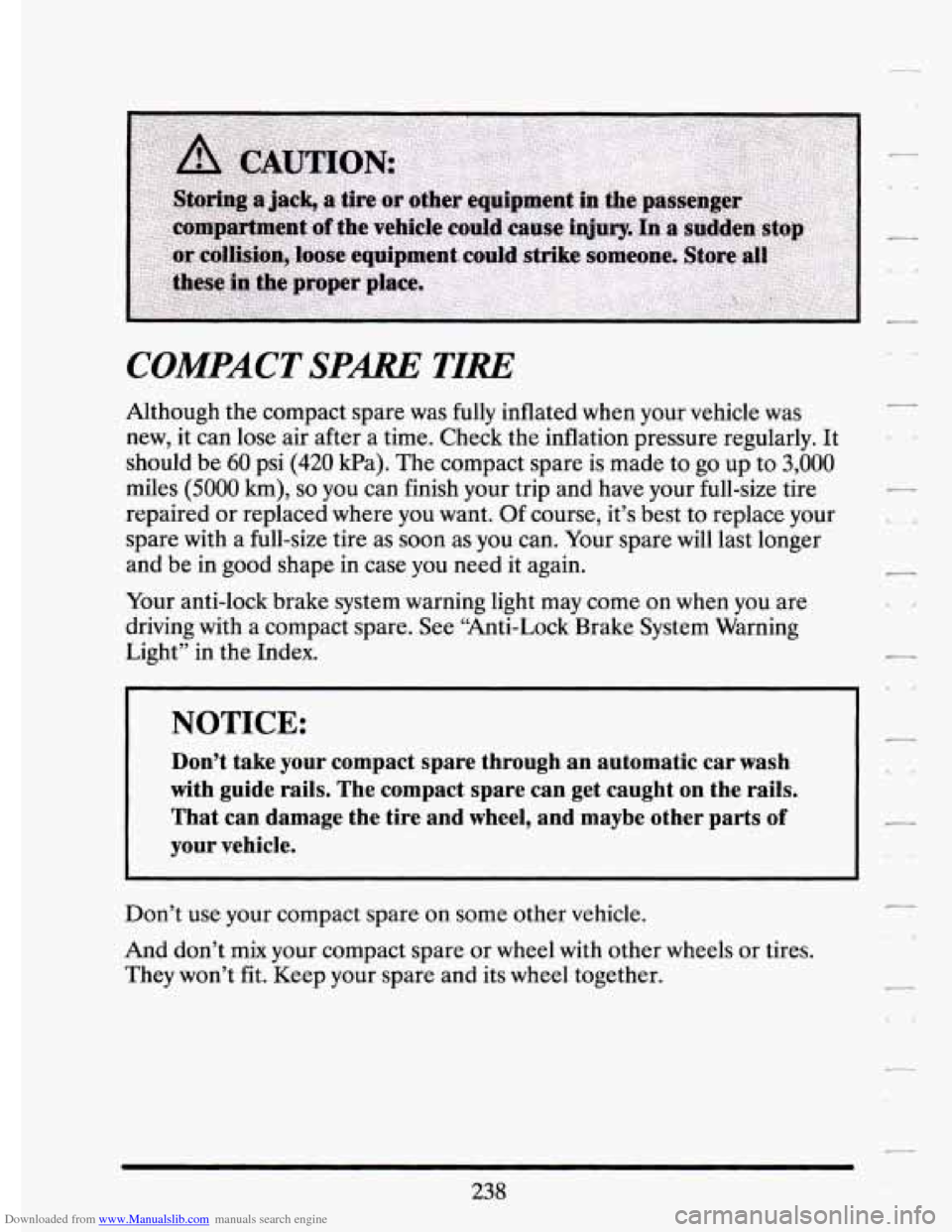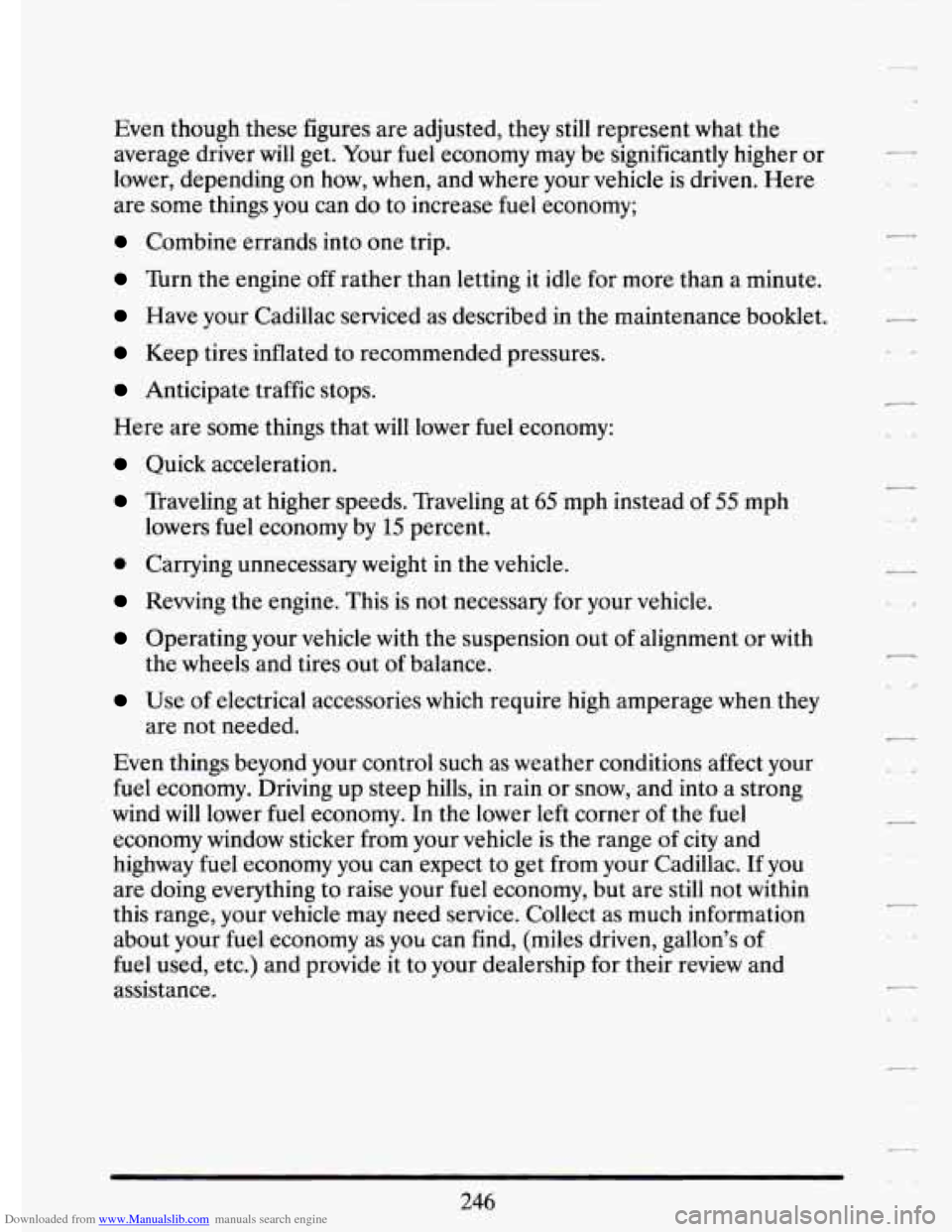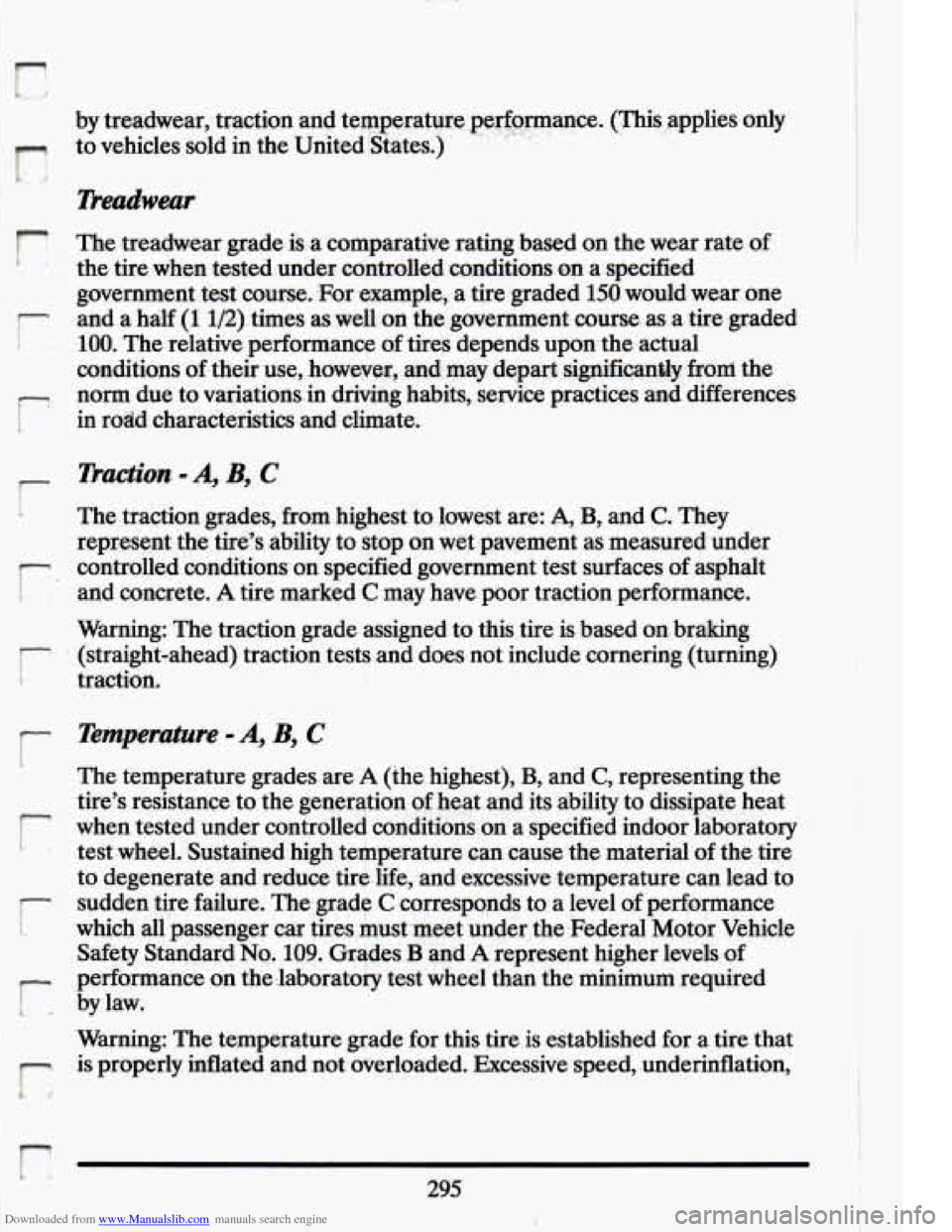Page 249 of 398
Downloaded from www.Manualslib.com manuals search engine p
!
I r
Tighten. the wheei
nuts firmly
in a
criss-cross sequence
as
shown.
Don't -try to put a wheel aver on your compact spare tire. It won't fit.
Store the wheel cover.
in the .trunk until you have the flat tire repaired or
replaced.
'NOTICE:
Wheel covers won't fit on your compact spare. If you try to put a
,wheel
cover on your compact spare, you could damage the cover , ,
OF the .compact spare.
237
Page 250 of 398

Downloaded from www.Manualslib.com manuals search engine COMPACT SPm TIRE
Although the compact spare was fully inflated when your vehicle was
new, it can lose air after a time. Check the inflation pressure regularly.
It
should be 60 psi (420 kPa). The compact spare is made to go up to 3,000
miles (5000 km), so you can finish your trip and have your full-size tire
repaired or replaced where you want. Of course, it’s best to replace your
spare with a full-size tire as
soon as you can. Your spare will last longer
and be
in good shape in case you need it again.
Your anti-lock brake system warning light may come on when you are
driving with a compact spare. See “Anti-Lock Brake System Wa\
rning
Light”
in the Index.
r
NOTICE: -
Don’t take your compact spare through an automatic car wash
with guide rails. The compact spare can get caught on the rai\
ls.
That can damage the tire and wheel, and maybe other parts
of
your vehicle.
Don’t use your compact spare on some other vehicle.
And don’t mix your compact spare or wheel with other wheels or tires.
They won’t fit. Keep your spare and its wheel together.
238
Page 258 of 398

Downloaded from www.Manualslib.com manuals search engine Even though these figures are adjusted, they still represent what the
average driver
will get. Your fuel economy may be significantly higher or
lower, depending
on how, when, and where your vehicle is driven. Here
are some things you can do to increase fuel economy;
Combine errands into one trip.
Turn the engine off rather than letting it idle for more than a minute.
Have your Cadillac serviced as described in the maintenance booklet.
Keep tires inflated to recommended pressures.
Anticipate traffic stops.
Here are some things that
will lower fuel economy:
Quick acceleration.
Traveling at higher speeds. Traveling at 65 mph instead of 55 mph
0 Carrying unnecessary weight in the vehicle.
Rewing the engine. This is not necessary for your vehicle.
lowers fuel economy
by 15 percent.
Operating your vehicle with the suspension out of alignment or with
the wheels and tires out of balance.
Use of electrical accessories which require high amperage when they
are not needed.
Even things beyond your control such as weather conditions affe\
ct your
fuel economy. Driving up steep hills, in rain or snow, and into a strong
wind will lower fuel economy. In the lower
left corner of the fuel
economy window sticker from your vehicle is the range
of city and
highway
fuel economy you can expect to get from your Cadillac. If you
are doing everything to raise your fuel economy, but are still not within
this range, your vehicle may need service. Collect as much information
about your
fuel economy as you can find, (miles driven, gallon's of
fuel used, etc.) and provide it to your dealership for their review and
assistance. LA
Page 299 of 398
Downloaded from www.Manualslib.com manuals search engine r
r 1
r
t T
r
r
n
r
, Once you have
replaced-the air
cleaner filter, reverse
the steps to-reassemble.
and install back into
.your vehicle.
. ..
LOADING YOUR WEHICLE
1"
TIRE-LOADING INFOR'MATION.
OCCUPANTS VEHICLE CAP.
WT.
FRT; CT.R. RR. TOTAL: LBS.. KG
MAX. LOADING &.GVWRSAME AS'VEHICLE
TIRE SIZE SPEED
PRESSURE
CAPACITY WEIGHT . XXX COLD TIRE
RTG
PSVKPa
F RT.
R R.
SPA.
IF TIRES ARE HOT. ADD 4PW28KPa SEE
OWNER'S, MANUAL FOR: ADDITIONAL
INFORMATION
Two labels on your vehicle. show how much weight it may prope,rly carry.
The Tire-Loading Information label found on.the driver's door tells you
the proper size, speed rating and.recommended inflation pressures for
the tires on your vehicle.
It also gives you important information about
the number of people that can be in your vehicle and the total weight that
B" 287
Page 302 of 398
Downloaded from www.Manualslib.com manuals search engine Ii@ktion - Tire Pressure
The Tire-Loading Information label which is located on the driver’\
s door
shows the correct inflation pressures for your tires, when they’re cold\
.
“Cold” means your vehicle has been sitting for at least three hours or
driven
no more than a mile.
Eldorudo (270 hp)
k€ you’ll be driving at speeds higher than 100 mph (160 km/h) where it is
legal, raise the ‘‘mldYy inflation pressure of each tire to 35 psi (240 Wa).
When you end this very high speed driving, reduce the “cold” inflation
pressures to those listed on the Tire-Loading Information label.
290
a
0
0
a
Page 303 of 398
Downloaded from www.Manualslib.com manuals search engine i
NOTICE:
.. - , .., .. . **:. 7 ' . ..._ ^ . ,
Don't let anyone tell you that underinflation or overinflation is
all right. It's not. If your tires don't have enough air
(underinflation) you can get:
Too much flexing.,
Too much heat
Tire overloading
0 Badwear
Bad handling
0 Bad fuel economy.
If your tires have too much air (overinflation), you can ger:
Unusual wear
Bad handling
Rough ride
0 Needless damage from road hazards.
How to Check
Use a good quality pocket-type gage to check tire
pressure. Simply looking at the tires will not tell
you the pressure,
especially
if you have radial tires -- which may look properly' inflated even
if they're underinflated.
If your tires have valve caps, be sure to put them back on. They help
prevent leaks by keeping out dirt and moisture.
When to Check Check your tires once a month or more.
The Eldorado tire pressures are:
0 Front - 28 psi (190 Pa)
Rear - 26 psi (180 kPa)
Page 304 of 398
Downloaded from www.Manualslib.com manuals search engine ELDORADO recommended tire size is:
Michelin XW4 Blackwall (P225/60R16)
Optional Michelin XW4 Whitewall (P225/60R16)
The ETC tire pressures are:
Front - 29 psi (200 kPa)
Rear - 29 psi (200 kPa)
ETC recommended tire size is:
Eagle GA (Z-Rated) Blackwall (P225/60ZR16)
Don’t forget your compact spare tire. It should be at
60 psi (420 kPa).
Tire Inspection and Rotation
To make your tires last longer, have them inspected and rotated at the
mileages recommended in the Maintenance Schedule.
I
Use this rotation
pattern.
After the tires have been rotated, adjust
the front and rear inflation
pressure
as shown on the Tire-Loading Information label. Make certain
292
Page 307 of 398

Downloaded from www.Manualslib.com manuals search engine E
l by treadwear,-traction and teqqerature gwfQrmance. (This applies only
r
to vehicles sold in the United (States.)
Treadweat
. . , .--, . .
r The treadwear grade is .a comparative rating based on the wear rate of
the tire when tested .under controlled -conditions on a specified
.government test course. .For example, a tire graded 150 would \
wear one
and a half
(I 1/2) times as well on the government course-as a tire graded
’ 100. The relative performance of tires depends uponthe .actual
conditions of.their use, however, and may depart significant@
frorri the
norm due to variationsin driving habits, service practices and differences
in rodd characteristics and climate.
.r Daction -A, B, C
t The traction grades, from highest to lowest are: A, B, and C. They
represent the tire’s ability to stop on wet-pavement as measured under
controlled conditionson specified government test surfaces of asphalt
’ and concrete. A tire marked C may have poor traction p.erformance.
Warning: The traction. grade assigned to this tire is based on braking
(straight-ahead) traction tests and doemot include cornering (turning)
r traction.
r Temperature -A, B, C
I I
The temperature grades. are A (the. highest), B, and C, representing the
tire’s resistance to the generation of heat and its ability to dissipate heat
when tested under controlled conditions.on a specified indoor laborato\
ry
test .wheel. Sustained
high tevperature can cause the material of the tire
to degenerate and reduce tire.life, and excessive temperature can lead to
- sudden tire failure. The.gradq C corresponds to a level of performance
1- which all passenger car tires mustmeet under the,Federal Motor Vehicle
Safety Standard
No. 109. Grades €3 and A represent higher levels of
performance on thelaboratory test wheel than the.minimum required\
e- bylaw.
Warning: The temperature grade for this tire is established for a tire that
is. properly inflate.d and not overloaded. Excessive speed, unde\
rinflation,
I
r
295